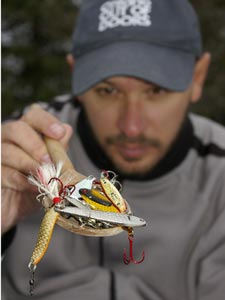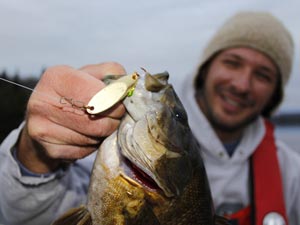
 |
| Spoons have been a proven method for catching summer smallmouth. |
Most anglers own a collection of jigging spoons, but for many, they are relegated to the third or fourth drawer of the tackle box — destined to rarely get wet. For those that jump on this vertical approach, though, big fish and plenty of them are yours to reap. Primarily a fall tactic that produces tremendous results, spoons are also a proven method for connecting with summer smallmouth. Knowing where to look and what to do will give you the knowledge for getting into fish.
The Art of Spooning
Spoon jigging is the truest form of vertical presentations. To be effective, your metal offering is directly under your rod tip when being worked, and casting rarely comes into play. This falls in sharp contrast to the "chuck and wind" mentality most of us posses.
Moving out and away from shorelines is another necessary commitment. We're programmed to fish visible structure the majority of the time, but when using jigging spoons, this is not part of the equation.
Jigging spoons offer a controlled technique; you're keying in on locatable fish that are virtually impossible to catch through any other method. Bottom line is — they look and act real.
Beginning Your Search
The summer months will find a healthy population of smallmouth bass relating to off-shore humps, staging over or adjacent to points, or suspended within deep mid-lake regions. Much of this will rely on the presence of baitfish.
Summer can be productive, but it can also be a hit and miss time period.
Come fall, these specific locations become much more concrete. Smallmouth will follow prey to their wintering grounds, and set up shop alongside this swimming buffet table. They will school in large groups, congregating in specific spots, and thereby creating easy pickings for a well-presented jigging spoon.
Water 20 feet and deeper should get all the attention, and I have found that water between 30 and 40 feet deep has often supported the highest concentrations of fish.
Keep your eyes peeled for "pods" of baitfish to appear on your sonar screen. Depending on your unit, this will often take the form of a large dark cluster, or a series of smaller clusters.
Setting Up Shop
 |
| Most strikes on a jigging spoon come as the bait free-fails after a hit. |
Once baitfish and smallmouth bass are located, a series of steps should be followed. If your boat has an onboard GPS unit, punch in the coordinates. This will help you locate the general area if you drift far from the school. I like to toss out a marker buoy. Again, this aids in orientating yourself to the school, and helps with establishing your bearings.
Maintaining direct overhead contact with the school is imperative. Since the technique is of a vertical nature, any significant variance away from the pack will find your lure in dead water. If the bait pods or hooks disappear from your sonar screen, slowly work the boat outwards from the last known coordinates or marker buoy until you reconnect.
Jigging Up a Storm
Working a jigging spoon is fairly simple. Once your boat is in position, open the bail of your reel and let the spoon descend on a slacked, but controlled, line. An average rule of thumb for fall rates is one foot per second. This can, however, vary depending on size, weight and action of the spoon.
I prefer to keep my rod in the 8 or 9 o'clock position. This gives me leverage for upward sweeps of the rod during hooksets, while also minimizing stress on the forearms. To impart action to the spoon, I utilize lifts or "wrist snaps," and will bring the rod to a 10 or 11 o'clock position at the height of the raise. Once there, immediately allow the spoon to flutter back down to the starting position, ensuring it falls on a slack line. The speed and height you lift the rod can vary, and is usually dictated by the mood of the fish. Some bass may respond better to an aggressively worked spoon, while others may only hit metal that barely moves. Experiment with cadence, pause rates, and lift heights to see which the fish react to best.
Most strikes on a jigging spoon come as the bait free-falls after a lift. The flash, in conjunction with the erratic darting and fluttering action, is often too irresistible for a smallmouth bass.
The Perfect Spoon?
 |
| The perfect spoon for the author would measure 2 1/2 inches long, weigh 3/4-ounces and be silver in color. |
The preferred length of spoon for jigging up smallmouth bass falls between 2 and 3 inches. It is generally thin and tapered, will weigh between 1/2 and 1 ounce, should be adorned with a high-quality treble hook, and come standard in a flashy hue.
Of course, baits can come in a hammered or smooth finish, spruced up with feathers or tinsel, sporting rattle mechanisms, and painted any colour under the sun. The variations are endless.
If I could choose one "go-to" spoon for smallmouth bass, it would measure 2 1/2 inches in length, weigh 3/4 of an ounce, and be silver in color. This is a definite standby on the smallmouth scene.
Equipment Considerations
Depending on personal preference, jigging spoons can be worked effectively with both spinning and baitcast gear. Choose a rod between 6 1/2 and 7 feet long, in a medium heavy action. You'll want a considerable amount of backbone in the rod itself and a slightly limber tip.
If using monofilament, choose either 14- or 17-pound test. My preference, however, especially if using spinning gear, is for 20-pound test braid used in conjunction with a 15-pound test fluorocarbon leader. This combo gives the angler better feel and sensation, while also creating an "invisible" link to the spoon.
Give spoons a try this season for your resident smallmouth — you'll be glad you did.
- 7661 views

